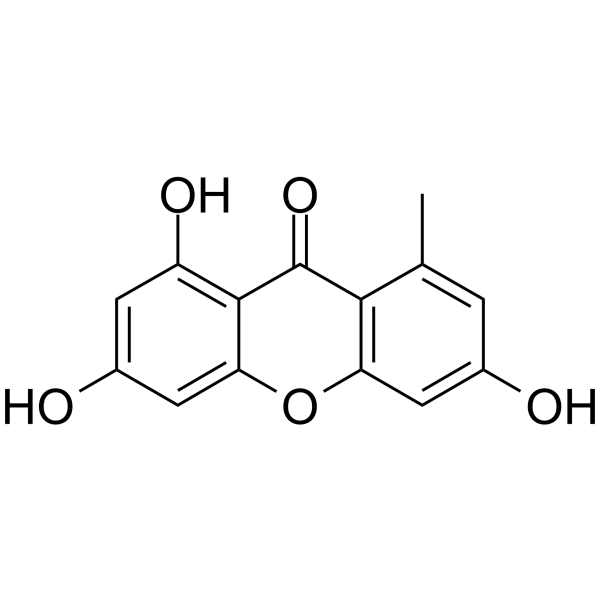
Norlichexanthone
CAS No. 20716-98-7
Norlichexanthone( —— )
Catalog No. M29328 CAS No. 20716-98-7
Norlichexanthone has the potential to treat and/or prevent lifestyle-related diseases such as type 2 diabetes, metabolic syndrome, atherosclerosis and cardiovascular disease.
Purity : >98% (HPLC)
 COA
COA
 Datasheet
Datasheet
 HNMR
HNMR
 HPLC
HPLC
 MSDS
MSDS
 Handing Instructions
Handing Instructions
| Size | Price / USD | Stock | Quantity |
| 100MG | Get Quote | Get Quote |


|
| 200MG | Get Quote | Get Quote |


|
| 500MG | Get Quote | Get Quote |


|
| 1G | Get Quote | Get Quote |


|
Biological Information
-
Product NameNorlichexanthone
-
NoteResearch use only, not for human use.
-
Brief DescriptionNorlichexanthone has the potential to treat and/or prevent lifestyle-related diseases such as type 2 diabetes, metabolic syndrome, atherosclerosis and cardiovascular disease.
-
DescriptionNorlichexanthone has the potential to treat and/or prevent lifestyle-related diseases such as type 2 diabetes, metabolic syndrome, atherosclerosis and cardiovascular disease. Norlichexanthone has antibacterial and antimalarial activity, it has strong activity against Bacillus subtilis with an IC50 range of 1- 5uM, and also has strong inhibitory effect on the growth of methicillin-resistant Staphylococcus aureus with an IC50 of 20.95±1.56 uM.(In Vitro):The butanol extract of a fungus P16 culture extract possessed such an activity, and isolated Norlichexanthone as an active compound through activity-guided fractionation. Oil red O staining showed that Norlichexanthone induced adipogenesis in ST-13 cells. Its differentiation-inducing activity was supported by the observation that Norlichexanthone dose-dependently increased the mRNA expression of fatty acid-binding protein and peroxisome proliferator activated receptor γ (PPARγ), markers of adipocyte differentiation. Western blot analysis demonstrated that the compound enhanced the secretion of adiponectin protein in a dose-dependent manner. An increase in mRNA expression of adiponectin was also observed in the Norlichexanthone-treated ST-13 cells. Actinomycin D treatment blocked the enhancement of adiponectin mRNA expression by Norlichexanthone, suggesting that it is the result of increased transcription. A luciferase reporter assay indicated that Norlichexanthone was unlikely to be an agonist of PPARγ, implying that its action of mechanism might differ from those of thiazolidinediones which upregulate adiponectin expression via activation of PPARγ.
-
In Vitro——
-
In Vivo——
-
Synonyms——
-
PathwayGPCR/G Protein
-
TargetAntibacterial
-
RecptorAntibacterial
-
Research Area——
-
Indication——
Chemical Information
-
CAS Number20716-98-7
-
Formula Weight258.23
-
Molecular FormulaC14H10O5
-
Purity>98% (HPLC)
-
Solubility——
-
SMILESCc1cc(O)cc(Oc2c3c(O)cc(O)c2)c1C3=O
-
Chemical Name——
Shipping & Storage Information
-
Storage(-20℃)
-
ShippingWith Ice Pack
-
Stability≥ 2 years
Reference
molnova catalog



related products
-
Sulfisoxazole acetyl
Sulfisoxazole acetyl is an agent with antibacterial activity. Sulfisoxazole acetyl is a Sulfisoxazole derivative with antibacterial activity. Sulfisoxazole acetyl is an inhibitor of dihydropteroate synthase.
-
WCK-4234 sodium
WCK-4234 sodium is an inhibitor of β-lactamase can be used in studies targeting MDR infections. WCK-4234 sodium inhibits class A, C, and D β-lactamases and OXA carbapenemases.
-
Antibiotic-5d
A synthetic antimicrobial compound that antibacterial activity in vitro against various Gram-positive and Gram-negative bacteria, fungi and yeast.



 Cart
Cart
 sales@molnova.com
sales@molnova.com


